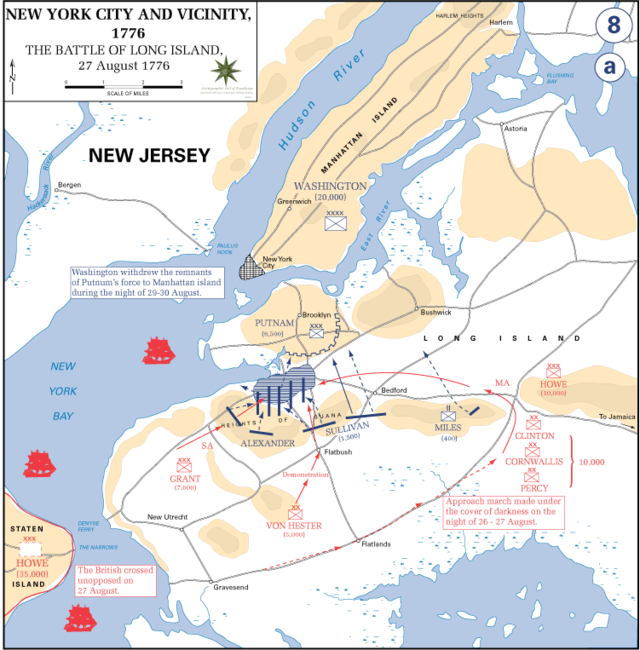The Battle of Long Island on 27 August 1776.
We lost.
George Washington, fresh from his victory pushing the British out of Boston, came south, knowing that the British wanted New York’s large harbor. He settled in for the defense.
The British fleet arrived and offloaded troops on Staten Island. Eventually, the British crossed the bay and landed in Brooklyn. I won’t get into the details of the battle, as shown on my handy West Point Department of History map (not surprisingly, we didn’t spend too much time on this battle—although for one semester I had an instructor from Sandhurst, the British Military Academy and he wanted to discuss it, for some reason). Bottom line? The British outflanked the Americans and Washington retreated to Manhattan.
Then he retreated up the island, engaging the advancing British several times before having to do the thing any New Yorker hates: retreat to New Jersey.

Courtesy Department of History, United States Military Academy
They didn’t know it at the time, but this would be the largest force on force battle of the war. Over 40,000 soldiers and sailors took part.
The British reported 59 killed, 268 wounded and 31 missing. The Hessian mercenaries fighting with them reported 5 killed and 26 wounded.
The Americans reported 300 killed and over a thousand captured. Those captured would suffer a terrible fate in prison ships, covered elsewhere in this book, but it’s estimated that less than half of those would survive their ordeal.
As a sidenote, the Army owed a great debt of gratitude to the First Maryland Regiment which bravely fought and kept the Army from being overrun. They took two-thirds casualties, around 256 and the dead were buried in a mass grave. The location of that grave still remains a mystery.
While it was a defeat for Washington, his ability to retreat the following night and day proved a strategic masterpiece, allowing the Army to survive.
I touch on this tangentially in two books: Nine Eleven (the Staten Island Peace Conference) and Equinox (Nathan Hale’s execution).
New York City would become the center of British forces in North America throughout the Revolution.
Evacuation Day, on 25 November 1783, when the last British left the city was long celebrated in the city.
The statue of George Washington in Union Square Park commemorates Washington’s return to the city on that date. It is also in a scene in New York Minute.
On Evacuation Day 1864, the Booth Brothers (one named James Wilkes Booth) performed Juliet Caesar at the Winter Garden Theater. That same day, Confederate saboteurs attempted to burn down the city by igniting a building next door to the Theater. What a coincidence.
In 1863, Abraham Lincoln proclaimed the last Thursday in November to be Thanksgiving Day and eventually Evacuation Day fell out of favor as it was now a redundant holiday.
Excerpted from: New York City Little Black Book 1: Secrets, History, and Trivia of the World’s Greatest City.

Recent Comments